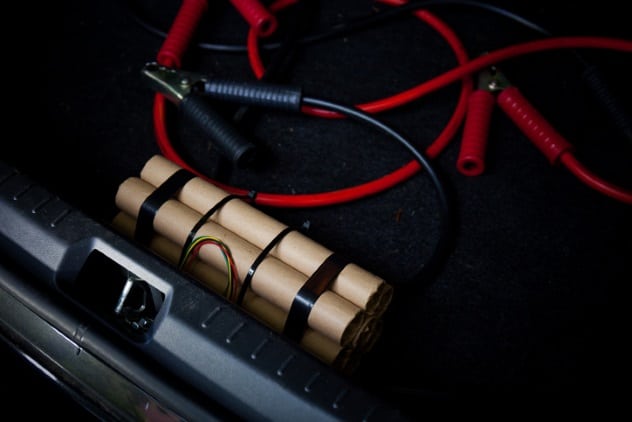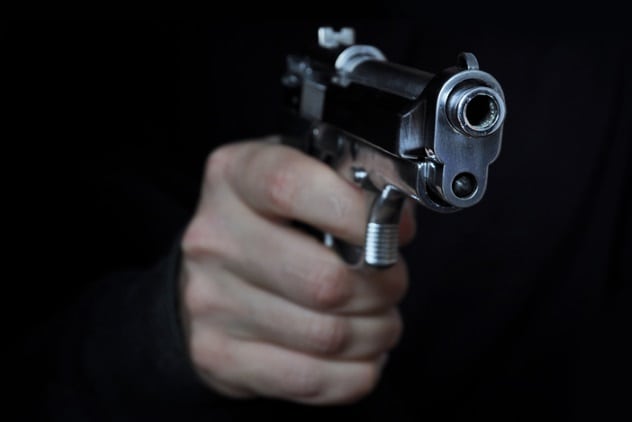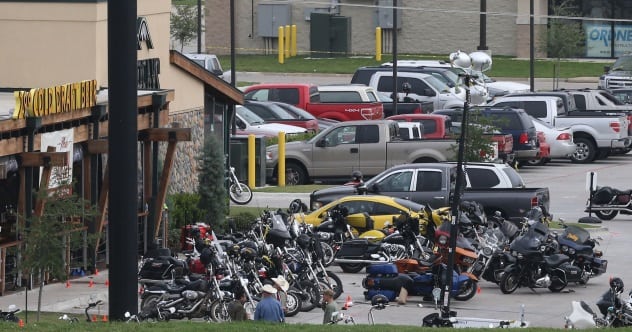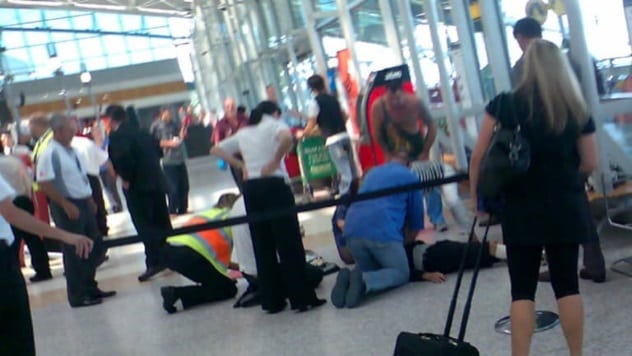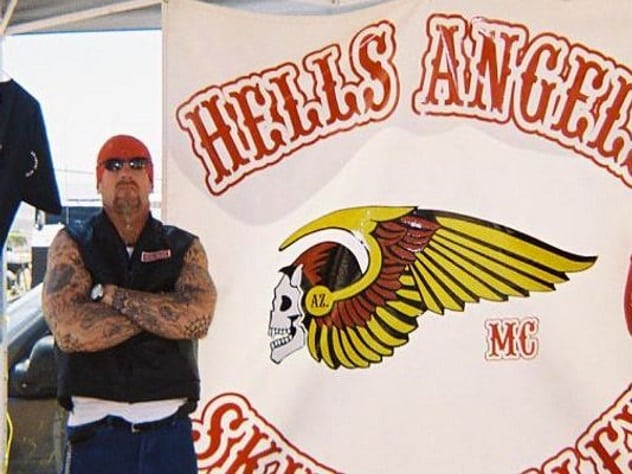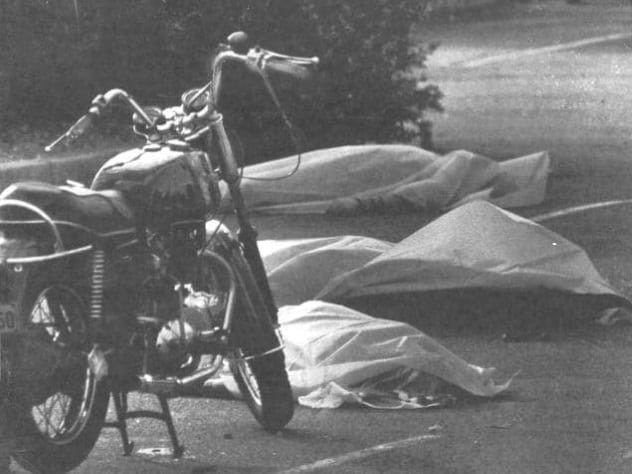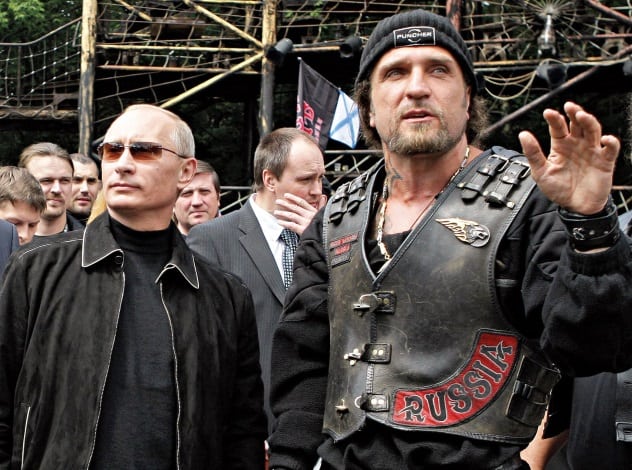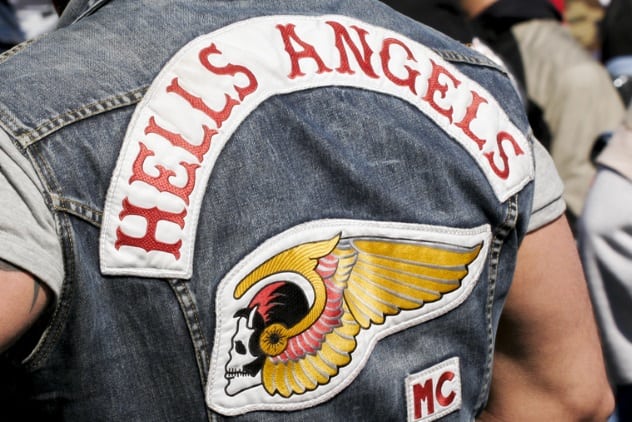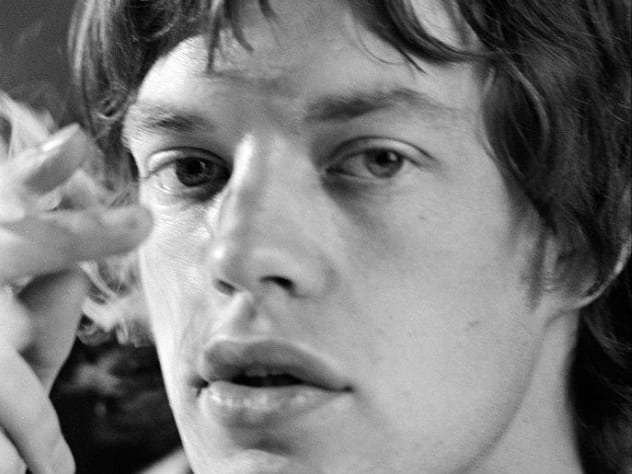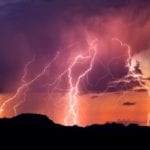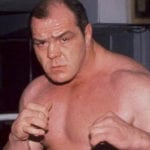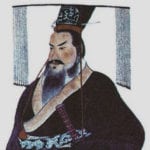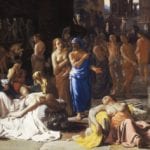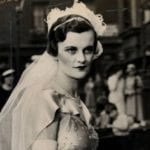Some have even grown so powerful that they’ve not only expanded their illegal activities across multiple continents but have climbed so high that they literally exited the Earth’s atmosphere. They’ve crossed paths with the media, law enforcement, celebrities, and even prime ministers in their ride to the top.
10 Trying To Blow Up The Police
In 2010, police in California decided that a notorious motorcycle club like the Vagos required round-the-clock surveillance by their gang enforcement unit. The Vagos, however, were having none of it. After they’d grown tired of having eyes on them at all times, a series of deadly booby traps were discovered at the homes and headquarters of the unit’s officers. Some proved quite inventive. Outside the headquarters, a rifle was rigged to go off when anyone opened the building’s security gate. Luckily, the gate’s wheels were worn out, and the officer who opened it had adjusted his position for better leverage, which moved him out of the firing range of the trap. Even then, the bullet missed his face by only 20 centimeters (8 in). Another officer’s car was rigged with bomb outside a convenience store, but he likewise survived because he noticed that his vehicle had been tampered with. The most brazen booby trap, however, was a gas pipeline inserted into a hole drilled into the roof of the unit’s headquarters. The gas was highly flammable and would have blown up the entire building with the slightest spark had officers not noticed the smell and evacuated.[1]
9 Joining Forces To Oust An Even More Violent Gang
During the 1980s, Western Australian outlaw biker club culture was ruled by the Big Four: the Coffin Cheaters, Gypsy Jokers, God’s Garbage, and Club Deroes. The groups coexisted in relative peace (for outlaw biker gangs) beside several smaller clubs. Yet many of those smaller groups disappeared after an event that became known as the Mongrel Mob Conflict, when they were absorbed into the Big Four after rallying together for a common cause.[2] The Mongrel Mob was a New Zealand-based gang notorious for violent crime. Their reputation preceded them, and when the Mob tried to create a chapter on the Big Four’s turf, the biker clubs decided to take action by putting their differences aside to join forces against the Mob. In 1989, they launched an attack on a repair shop run by Selwyn Wharepapa, the Mob chapter’s vice president, firebombing the business and shooting Wharepapa in the groin. The biker clubs claimed they were doing local citizens a favor running the Mob out of town. Wharepapa rebutted by saying he was just trying to run an honest business. (The Big Four stated that the Mob had given them an ultimatum to be accepted in Australia “or else.”) Whatever the case, the Mob negotiated a surrender and left the area soon after.
8 A Police Setup?
On May 17, 2015, a bimonthly meeting of Texas biker clubs was held at the Twin Peaks restaurant in Waco. It was meant to discuss issues and laws relevant to the biker lifestyle. Among those in attendance were the Bandidos, notorious for their criminal activity, but since all manner of bikers attended the meeting, this was nothing new. What was different about this particular gathering, however, was that the Cossacks, a rival outlaw biker gang, arrived shortly after. There was an argument. It almost immediately devolved into a fierce battle that left nine people dead and 20 wounded. The police were already close by and managed to respond within 40 seconds, which probably prevented even more fatalities. Some bikers, however, accused them of instigating the violence. The police rounded up every biker present, even those who arrived after the shoot-out or were hiding in the bathrooms. They then released documents detailing how the outlaw clubs had received weapons from ex-military members in biker gangs that didn’t even exist. A total of 177 bikers were charged with minor legal infractions, but it’s suspected that the charges were only made to avoid wrongful imprisonment suits after they were detained. Officers admitted to signing affidavits in bulk without specifying evidence against individual defendants. A grand jury was convened, though the foreman was a Waco PD detective who was “randomly selected.” He even wore his badge and service arm to his first day as a grand juror in the ensuing police misconduct case.[3]
7 An Airport Murder With An Audience
On March 22, 2009, Hells Angels (spelled “Hells,” without an apostrophe) Sydney chapter president Derek Wainohu took a plane back home from Melbourne. Normally, this would have been a nonevent, but that day, five rival Comancheros happened to be on the same plane. The clubs had already been engaged in a conflict for two years, and when the five Comanchero disembarked, they started threatening Wainohu. Texts messages and calls soon went out from both sides. More and more members were rallied to the airport in preparation for an all-out battle. Eventually, the two warring sides met near the check-in counter. Several began using steel bollards as weapons. Knives were brought out, and even scissors. The scuffle ended with Anthony Zervas, younger brother of Hells Angel Peter Zervas, dead from stab wounds and serious head trauma from being stomped on by the Comancheros in front of a lobby full of airport travelers. Several Comancheros were charged with murder. The event led to the Comanchero president, Mahmoud Hawi, calling for peace. The parley was proven insincere, however, when only shortly after, Zervas’s older brother was shot dead in his driveway. Hawi turned himself in and was found guilty in connection with the murder. He was sentenced to 28 years in prison, but several years later, the conviction was downgraded to manslaughter. He was released, but his freedom was short-lived. Just a few years later, he died from a gunshot wound to the face.[4]
6 ATF Abandons The Agent Who Infiltrated The Hells Angels
Former ATF agent Jay Dobyns is the only undercover operative who successfully became a “patched” member of the Hells Angels in Mesa, Arizona. (The Hells dispute this, saying they never gave him a patched vest.) He assumed his undercover identity in 2001, and it was a long journey convincing the Hells that he was one of their own, but they finally accepted him into their inner circle when he bashed in the head of a rival Mongols member. The man he “murdered,” though, was in fact an undercover police officer who had infiltrated the Mongols, just covered in cow brains and splashed with blood. Dobyns photographed him as evidence of the kill. Then he was inducted into the Hells without the normal one-year probation period.[5] Before long, a Hells member brutally murdered a woman named Cynthia Garcia and buried her nearly decapitated body in the desert. His guilty conscience got the better of him, though, and he turned informant. His information, along with intel gathered from Dobyns, another informant, and two other undercover officers, led to a large, multistate sting on the Hells in 2003. Fifty-two arrests were made, and several members were indicted on racketeering and murder. Soon after the raid, Dobyns began receiving threats from the Hells. His house was burned down. But despite his many sacrifices, the ATF decided that giving him a new identity was not “cost-effective.” Dobyns sued in 2008, and after a six-year court battle, a federal judge gave the ATF a scathing rebuke of their dishonorable practices. She awarded Dobyns $173,000 in damages and denied the government royalties from his book about the incident, which they had been trying to claim.
5 The Milperra Massacre
In 1984, the Bandidos expanded into Australia. They set up their first chapter in Sydney—right in the heart of Comanchero territory. Tensions rose steadily, but things boiled over when two Comancheros defected to the new club and burned their old colors. War was declared, which culminated in a vicious battle that left seven dead, including an innocent 14-year-old girl. Twenty-one others were terribly injured. It happened at a bike swap meet in front of the Viking Tavern. About 500 people were already there when the Comancheros rolled in. It seemed they had been expecting violence, because they were armed to the teeth. The Bandidos arrived soon after, equally well-armed. Bullets started to fly, and bystanders ran screaming for cover.[6] When the dust finally settled, the dead and injured lay across the parking lot. Alongside six bikers, young Leanne Walters had been killed by a wild rifle shot. Others were seriously injured, both bikers and bystanders, and the first responders to the scene were so scarred by what they witnessed that they required psychiatric help to deal with the trauma. The ensuing trial took years, and the bikers eventually spent years in prison (except for the Bandidos chapter president, Anthony Mark Spencer, who committed suicide in jail). Yet in the end, none even served their minimum sentence, having received various remissions to get out early. The now ex-bikers look back on the horrific event with regret. Many have since abandoned their old lifestyle. The story has been made into a TV documentary, and at least one of the bikers has written a book about his life in the outlaw club.
4 Putin Sends The Night Wolves Flag Into Space
The Night Wolves are Russia’s largest motorcycle club. They are staunch supporters of Russian patriotism and Orthodox Christianity and have such close ties to Vladimir Putin that they are considered a “soft power” of the Kremlin. During the fighting in Ukraine, when Russia annexed Crimea, they even fought alongside pro-Russian militias and helped storm a naval facility. It was not the first time the Wolves got involved in politics, having once assisted in a barricade of parliament to help thwart a failed coup against Gorbachev. This put them in the spotlight, and the club soon walked away from its outlaw biker origins and into the patriotic organization it is today. The shift was lead by Alexander Zaldostanov, who quickly shot to power within the Wolves’ ranks. The club is now famous for its large, patriotic bike shows, for which they receive millions in grants directly from the government. The club’s leader, known as “the Surgeon” for his former job as a dental surgeon, has received various medals and honors from Putin himself, who has ridden with the club several times. But the greatest honor bestowed upon them was when Putin ordered their flag carried into space by a cosmonaut.[7] Still, even as they dream of reuniting the Russian Motherland, some core members of the Wolves claim that their relationship with the Kremlin is not political, only that they both share the same interests. They say that both the state and the Wolves help defend the values of the Russian people from evil foreign influences.
3 The Quebec Biker Wars
When the Hells Angels first made headway into Canada during the late 1970s, they ran into the Outlaws, who had already established themselves in Ontario. The Outlaws quickly set to defending their turf, which set off the opening shots of what became known as the First Biker War in Canada. The Hells were victorious. They soon expanded into other provinces, but the expansion set off a chain of events that lead to an even more violent era. The Hells quickly earned a reputation for being a reckless organization, and other, more established crime syndicates wanted nothing to do with the wild, untrustworthy bikers. The Hells had to change. They had to become more businesslike. In 1985, to show how serious they were, they murdered several members of their own Laval chapter whom they deemed too undisciplined for the expansion.[8] They were also trying to absorb other biker clubs into their organization, but outrage spread after the Hells killed their own. Salvatore Cazzetta, a member of the SS motorcycle club, founded his own club, Rock Machine, in retaliation. Still, his brother had been absorbed into the Hells, and the two clubs stayed out of each other’s way. But then Salvatore was arrested on drug smuggling charges. Without his leadership, the Hells saw an opening and tried to take over street distribution on Rock Machine’s turf. War broke out again. Both gangs’ weapon of choice was dynamite stolen from the various mining operations in the area, and the many bombings and attacks left more dead that just bikers. When an 11-year-old boy was caught in one of the blasts, police started cracking down hard on the clubs. That only brought threats against police, prosecutors, and journalists covering the motorcycle groups. One journalist found his home ransacked and his radio set in his bathtub, mimicking the way several bikers had been found dead in their own homes. Eventually, the war turned against Rock Machine, and the remaining members patched over to the Bandidos, who later tried to expand into Canada. By most accounts, though, the Hells are still on top.
2 The Hollister Riot
Biker culture didn’t always have the “outlaw” stigma it does today. It was only in 1947 that the American Motorcyclist Association’s Gypsy Tour branded bikers with the “bad boy” image we’re now familiar with. The tour arrived in Hollister, California, but the sleepy little farm town wasn’t prepared for the influx of riders. Some 1,500 had registered, but it’s estimated that more than twice that arrived. What followed was a hospital full of injured bikers, a special session of night court created to handle the unexpected number of infractions, and 30 extra highway patrol officers blocking off the town’s main road. The jail soon overflowed with bikers. That said, it’s debated whether or not the Hollister incident did, in fact, deserve to be called a “riot.” Some say it was just the result of the media eager to sensationalize a town ill-equipped to handle a biker celebration. Others who researched the newspaper’s handling of Hollister say the stories tended not to exaggerate or add with each retelling, lending credibility to the accounts of the bikers’ bad behavior. Whether it was an event that got out of hand or the bikers did indeed deserve their outlaw reputation matters little now, however. The image of the biker outlaw is now cemented in popular culture.[9]
1 The Mick Jagger Assassination Attempt
The Altamont Speedway Free Concert in 1969 went down in infamy after the Rolling Stones hired the Hells Angels to provide security for the event. Reportedly on the advice of the Grateful Dead, the Stones gave the Hells $500 and free beer in exchange for their services. This ended in the filming of an 18-year-old man being beaten and stabbed to death by the Hells. After the disaster, Mick Jagger was so furious that he wanted nothing to do with the Hells Angels. That was when, unbeknownst to Jagger, the Hells started to plot against him. The Hells were angry at his treatment of them, so angry that they wanted revenge for what they took as a slight. Jagger had a waterfront property in the Hamptons, and the Hells devised a plan to sail a boat from the ocean right up to his garden, enter from the back to avoid security, and murder Jagger, along with anyone else on the property. Fortunately for Mick Jagger, the night the assassination was attempted, a large storm threw all the would-be murders overboard. While the bikers did survive, their thwarted attempt took the proverbial wind from their sails. The Hells decided not to go through with the assassination, and Mick Jagger would live to tour again.[10] Mike lives on the east coast and spends too much time at the beach.
